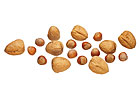
There’s a trend that’s catching on with select ingredient markets: specifying product origin. For some time, the vanilla industry has made a practice of indicating if beans used to make extract came from Madagascar, Tahiti, or some other tropical climate. This trend is catching on with chocolate and coffee . . . and has the potential to do so with nuts.
Single origin ingredients often have distinguishing sensory characteristics due to various ecological factors such as soil, rainfall, heat, humidity and adjacent crops. This creates unique aroma and flavor profiles in select ingredients grown in beans or pods. Nuts grow in a shell, so they are less influenced by these ecological factors. Nevertheless, it is still possible to market nuts with a little more oomph by specifiying where they are from.

Almonds originated in the Mediter-ranean region and are now cultivated in various countries surrounding the Mediterranean Sea, in Argentina and Chile, as well as in California, which is the largest producer of almonds in the world. Brazil Nuts come from the Amazonian rain forest. Their name is taken from the fact that most of the forest is part of Brazil. Cashews are native to South America and are now cultivated in South America, Africa, Vietnam and Eastern India. Hazelnuts, also called filberts, are native to Europe, but today the United States is one of the largest producers. Macadamia Nuts are native to Australia even though Hawaii is now the leading grower. Peanuts, not really a nut, rather a legume, are native to South America. Today they are cultivated in the United States, Africa, India, China and Indonesia.
North America owns pecans. The top-five pecan-producing states are Georgia, Texas, New Mexico, Arizona and Louisiana. (Think New Orleans praline pecan.)
Pistachios are native to Eastern Europe and are now also produced in California-the second largest growing region. Walnuts, too, are grown in California, as well as France, Italy, China and Chile.

A new clinical study published in the Oct. 17, 2006 edition of the Journal of the American College of Cardiology, suggests that walnuts, rich in polyunsaturated fats, may protect the body’s arteries from the harm associated with eating a meal high in saturated fat. Adding olive oil, known for its monounsaturated fats, does not appear to provide the same type of vascular benefits.
Preliminary results from a Pennsylvania State University study suggest that pistachios might significantly lower total and low-density lipoprotein (LDL) cholesterol levels. The purpose of the study is to evaluate the effects of pistachios on many heart disease risk factors, including changes in lipids (good and bad cholesterol) and lipoprotein metabolism, vascular health and markers of systemic inflammation.
And, because we all know peanuts go great in ice cream, but are a quality control nightmare because of their high allergenicity, here’s some good news. Recent research from the University of Florida, Gainesville, and published in the online version of Plant Science, identifies a new peanut gene. This gene apparently doesn’t instigate allergic effects related to protein identification by immunoglobulin E, the mammalian antibody that triggers powerful allergic reactions, including anaphylactic shock. This gene identification might help create an allergen-free peanut.